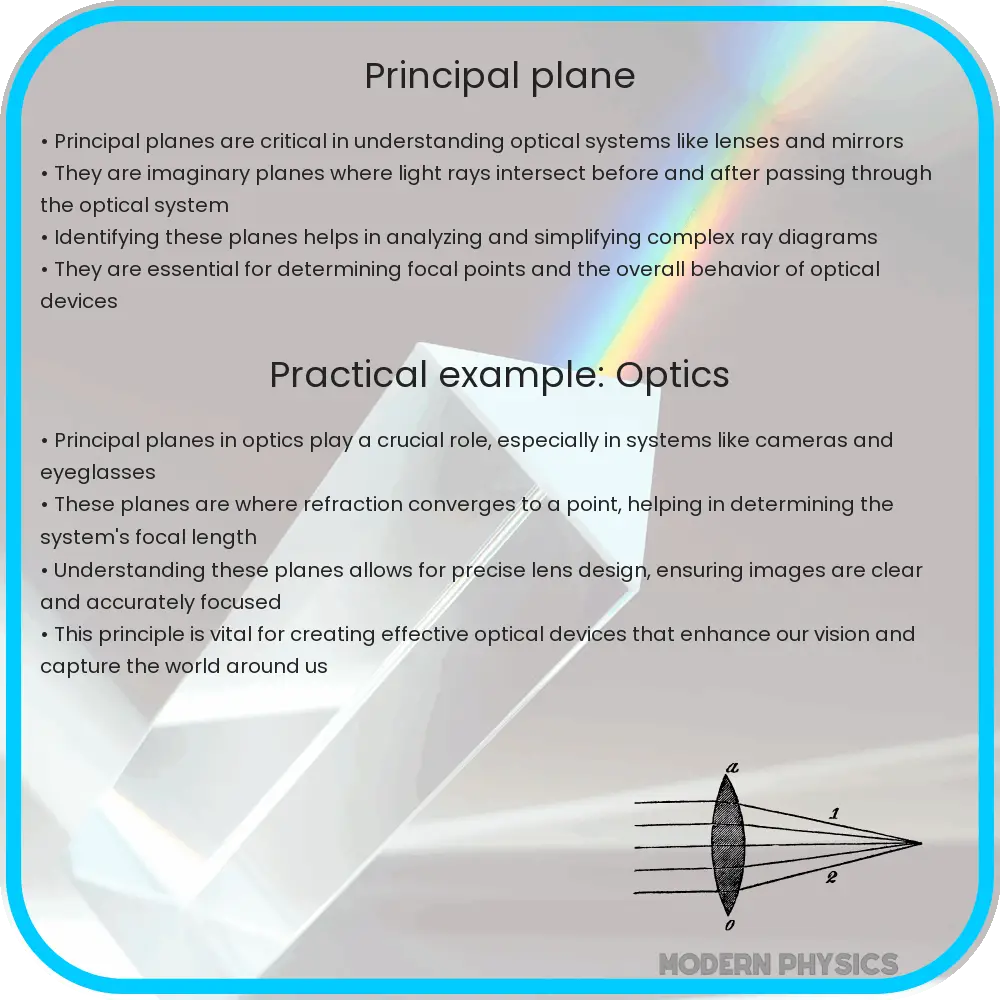Learn about principal planes in optics, crucial for understanding light behavior in optical systems and simplifying imaging calculations.

Understanding Principal Planes in Optics
Principal planes are critical in the study of optics, particularly when analyzing systems with multiple optical components like lenses and mirrors. These planes provide significant insights into how light behaves as it travels through optical systems, affecting both refraction and image formation.
What are Principal Planes?
In simple terms, principal planes are hypothetical surfaces in an optical system where light rays can be considered to refract or reflect at a single point as they pass through the system. In a complex optical instrument, such as a microscope or a telescope, these planes help simplify calculations related to light path and image formation.
Importance of Principal Planes
Principal planes are especially useful in determining the locations of images formed by optical systems. By understanding where these planes are, one can effectively predict how an object will appear through the system without detailed wavefront analysis, simplifying engineering and scientific calculations.
Refraction Through Principal Planes
Refraction is the bending of light as it passes from one medium to another of different density. When considering principal planes, refraction can be simplified to the bending occurring at the principal planes. This allows lenses, for instance, to be treated as if they were thin lenses located at the principal planes for the purpose of calculations.
- Cardinal Points: Principal planes are closely linked to the cardinal points of an optical system, which include focal points, nodal points, and the optical center. These are essential for understanding how optical systems like cameras and eyeglasses work.
- Parallel Ray Approximation: By assuming that rays hitting the principal planes are parallel, calculations simplify significantly. This approximation is useful in many practical applications where exact ray tracing is unnecessary or impractical.
Image Formation and Principal Planes
Image formation in optical systems is greatly influenced by how light interacts with the principal planes. By knowing the characteristics of these planes, it becomes easier to predict where and how an image will be formed, which is crucial for designing effective optical systems.
For example, in a camera, the lens system might contain several principal planes. Understanding their properties allows photographers and lens manufacturers to optimize image quality by predicting how lenses will focus light from different distances.
Equations related to principal planes often involve terms like focal length (f) and object distance (do). A basic equation that illustrates the relationship between object distance, image distance (di), and focal length for thin lenses is given by the lens formula:
\[ \frac{1}{f} = \frac{1}{d_{o}} + \frac{1}{d_{i}} \]
This equation, though simplistic, helps underscore the predictive power of understanding principal planes in complex optical systems.
Applications in Modern Technology
Principal planes find extensive applications in various fields of modern technology. In photography, understanding these planes is crucial for lens design, affecting focus and depth of field. In medical imaging, such as in endoscopes and microscopes, principal planes assist in accurate imaging necessary for correct diagnoses and research.
Furthermore, in virtual reality (VR) systems, principal planes are essential for creating lenses that minimize visual distortions and enhance user experience. As technology advances, the role of principal planes continues to expand in new and innovative optical designs.
Challenges in Practical Implementation
Despite their theoretical simplicity, the practical implementation of principal planes can pose challenges. Manufacturing imperfections, alignment errors, and material inconsistencies can all affect how accurately principal planes perform in real-world applications. Therefore, precise engineering and quality control are critical in the production of optical systems to ensure that they adhere as closely as possible to the theoretical models.
Moreover, advanced optical systems like those using adaptive optics to correct for atmospheric distortion require dynamic adjustment of principal planes, which introduces further complexity into the design and operation of these systems.
Conclusion
Understanding principal planes is fundamental for anyone involved in the design and application of optical systems. These hypothetical surfaces help simplify the complex interactions of light within optical devices, facilitating better design and more effective solutions in technology ranging from everyday eyeglasses to sophisticated scientific instruments.
The study of principal planes not only aids in enhancing existing technologies but also paves the way for innovation in emerging applications like augmented reality (AR) and high-resolution microscopy. As we continue to push the boundaries of what optical technology can achieve, the principles governing principal planes will play a pivotal role in guiding future developments.
Consequently, the continued exploration and understanding of principal planes symbolize a bridge between theoretical optics and its practical applications, reflecting the ongoing synergy between science and engineering required to meet the demands of an increasingly technologically advanced society.
